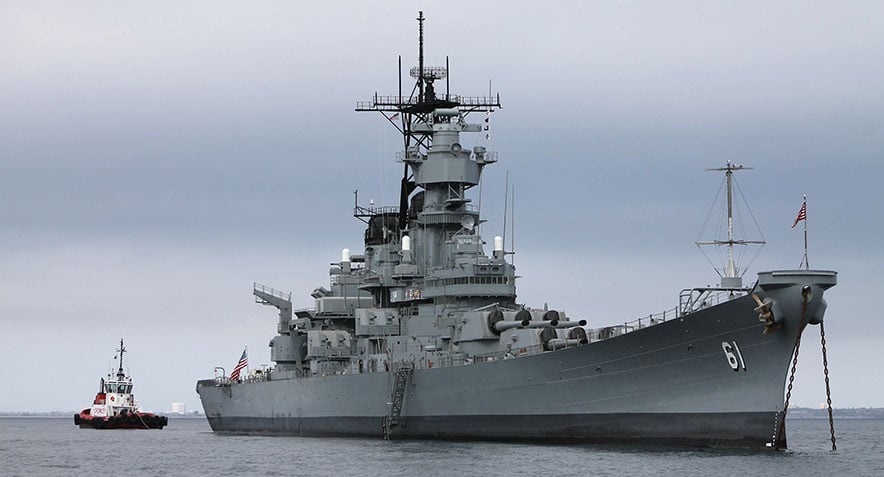Guarding A Floating Treasure
The USS Iowa has a legacy as rich as any battleship in U.S. naval history. The vessel, originally commissioned in 1943, escorted President Franklin D. Roosevelt across the Atlantic for a critical meeting that year of the Allies at the Tehran Conference, also attended by Soviet leader Joseph Stalin and British Prime Minister Winston Churchill.
Sent to the Pacific Theater during World War II, the battleship played a pivotal role in many battles there; it also saw action in the Korean War. Moreover, the ship has played host to more U.S. presidents than any other ship in history, earning it the nickname, “The Battleship of Presidents.”
The USS Iowa was decommissioned in 1990, and, to honor the mighty vessel’s historic role, was permanently berthed at the Port of Los Angeles in 2012 and converted into a museum.
Mike Dahl, security director of the Battleship Iowa Museum, says that protecting the floating historical asset while receiving visitors comes with challenges. “If you’ve ever been on a ship, it’s a little complicated. It’s not like a normal building.” he notes. “Our job here is not only to secure the ship, but to ensure the safety of our guests.”
Besides the vessel itself, several items in the museum have to be protected from theft or touching. “We have artifacts that date back to World War II when this ship was first in service that we’re concerned about,” he says.
The USS Iowa has a small permanent security team, plus a roster of around 50 volunteers who help run the museum. The tour routes on the ship are designated with ropes and signage, but Dahl notes there are many hazardous areas they want to keep visitors and crew members safe from. “If they make a wrong move they could wind up falling several decks down; they could end up with serious injuries, or even worse.”
Another concern for the USS Iowa is people who trespass after hours. While someone is aboard the ship at all times, Dahl says that it’s difficult for the one person who remains at night to monitor the entire vessel alone.
Since its inception, the museum had a few off-the-shelf cameras installed around the ship, but the security team wanted a more robust system for surveillance. In mid-2015, David Canfield, the museum’s vice president and chief information officer, along with the museum’s leadership team, chose Arteco NEXT VEMS (video event management) software to manage video and take advantage of analytics. They also upgraded to a network of 11 high definition IP cameras from Arecont Vision. Because the museum is a nonprofit, both vendors donated the respective technological solutions. “We rely on ticket sales, cash donations, and donated goods and services to help us out,” Canfield says.
The software was fully brought online in the beginning of 2016. Dahl notes that he didn’t require much training on the VEMS software because of its user- friendly interface. “The people from Arteco gave me a little bit of instruction on the software, and then it was just going through a little bit of hands-on learning on how to make it do what I wanted it to do,” he says.
With Arteco NEXT, users can look at a camera’s field of view and set up “violation zones,” where an alert is triggered if anyone crosses into the area. “I set it up so that if anybody steps into that area, it will notify me,” he explains. “The software immediately sends me an email with a snapshot of what triggered the alarm, so that I can immediately look at it if I’m here at the ship or if I’m at home or somewhere else.” There is also a notification set up for any time someone enters the cash-handling room, adds Dahl.
Recently, the exterior violation zone feature alerted Dahl to a trespasser coming aboard the ship at night. While Dahl himself wasn’t on board, he received the alert on his smartphone, and notified the person staying on the ship that night.
Based on the alarm snapshot, Dahl was able to tell the team member that the trespasser came up the forward gangway and turned toward the bow. “After that, I lost sight of him, but that was enough to give him the general direction,” says Dahl. “So he was able to locate the trespasser, then call the port police and have them come down and escort him off.” The trespasser, who jumped a fence to get onboard, was issued a citation.
The video is recorded on a six-week loop, which allowed Dahl to go back and review footage of the incident. “I was able to go back and see exactly how they got on the ship, and once they got to the top of the gangway, which direction they went,” he says.
In the future, Dahl would like members of the security team to have remote access to the cameras, and have a dedicated person to monitor them at all times. “That’s the eventual goal as we get things rolling,” he notes, “and I won’t have to be calling them and saying, ‘Hey, there’s somebody here.’”
Dahl also wants to add more cameras to cover the whole ship as resources allow. “Ideally, I want to put several more cameras in different places on the exterior of the ship,” he says, “plus put more inside to help cover some of the blind spots that you don’t see.”
